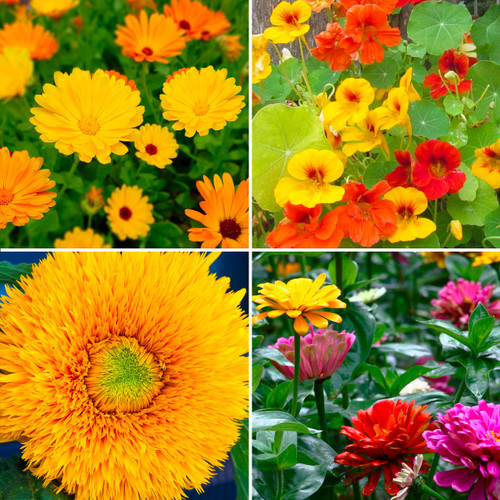
10 Long Blooming Perennial Favorites
Share
Perennials with a long blooming cycle is beloved by homeowners and gardeners
Gardens are places of wonder where colors, fragrances, and life come together to create a mesmerizing experience", states Tammy Sons of TN Nursery. While many perennials offer their beauty only briefly, some remarkable varieties bloom tirelessly, turning your garden into a year-round spectacle.
10 Perennial Favorites With Long Bloom Cycles

Coneflowers (Echinacea purpurea):
Bloom Time: Late Spring to Early Fall Coneflowers, also known as Echinacea, are a testament to the beauty of simplicity. With their striking purple-pink petals and iconic cone-shaped centers, these perennials stand tall and proud in any garden. Their long blooming season, stretching from late spring to early fall, makes them truly exceptional. Coneflowers add elegance to your landscape and attract pollinators, making them a garden favorite.

Orange Daylily (Hemerocallis fulva):
Bloom Time: Late Spring to Late Summer The orange daylily is a garden gem with its radiant, fiery blooms. Each flower lasts only a day, but these perennials produce abundant blooms on a single stalk, ensuring a prolonged show from late spring to late summer. Known for their low maintenance, they are a perfect choice for novice and experienced gardeners.
Sweet Violet (Viola odorata):
Bloom Time: Early Spring to Late Spring Sweet violets may have a relatively short blooming season, from early to late spring, but they bring elegance and fragrance to any garden. Delicate shades of purple, blue, and white adorn these dainty flowers. Their captivating scent and charming appearance make them a cherished addition to early spring landscapes.
Blanket Flower Perennial (Gaillardia spp.):
Bloom Time: Late Spring to Early Fall. Blanket flowers, basking in the sun's warmth, paint your garden with vivid red, orange, and yellow hues. These robust perennials offer an extended blooming season from late spring to early fall. Their daisy-like blooms captivate the eye, attract pollinators, and maintain a good ecosystem in your garden.
Maximilian Sunflower (Helianthus maximiliani):

Bloom Time: Late Summer to Early Fall Maximilian sunflowers are a late-blooming delight, adding a burst of sunshine to your garden as summer transforms into fall. Their golden-yellow flowers, adorned with prominent centers, provide a stunning contrast to the changing foliage. Maximilian sunflowers are ideal for gardens seeking to extend the season's warmth.
Butterfly Weed (Asclepias tuberosa):

Bloom Time: Late Spring to Early Fall Butterfly weed attracts butterflies and other pollinators. This native perennial produces bright orange or yellowish-orange flower clusters from late spring to early fall. Its striking appearance and pollinator-friendly nature make it an excellent choice for wildlife gardens.
Black-Eyed Susan (Rudbeckia hirta):

Bloom Time: Early Summer to Early Fall Black-eyed Susans are garden classics with cheerful yellow petals and dark centers. These perennials grace your garden with vibrant colors from early summer until the first frost. Renowned for their reliability and low maintenance, they are a staple in many gardens. Creeping Buttercup (Ranunculus repens: Bloom Time: Late Spring to Early Summer With its golden-yellow, cup-shaped flowers, creeping buttercup brings a touch of whimsy to your garden. While its blooming season extends from late spring to early summer, the dense, glossy green foliage adds charm to your landscape even when not in bloom. These perennials are perfect for ground cover and border planting.
Trumpet Vines Perennials (Campsis radicans):

Bloom Time: Late Spring to Early Fall. Trumpet vines are renowned for their striking trumpet-shaped, fiery orange-red flowers. They are vigorous climbers, adding vertical interest to your garden. These perennials bloom from late spring to early fall, attracting hummingbirds and pollinators with their vibrant blossoms.
Perennials are often referred to as the backbone of fine gardens

Primrose Plants (Primula spp.):
Bloom Time: Late Winter to Late Spring Primrose plants are among the earliest heralds of spring. They push through the late winter snow to reveal their delicate, cup-shaped flowers in shades of pink, purple, and yellow. While their blooming season spans from late winter to late spring, they symbolize hope and renewal in the garden.
Incorporating these ten long-blooming perennials into your garden

From the vibrant purple-pink petals of coneflowers to the fiery allure of orange daylilies, the fragrant elegance of sweet violets to the radiant hues of blanket flowers, and the late summer sunshine provided by Maximilian sunflowers to the pollinator-friendly blooms of butterfly weed, black-eyed Susans, and the whimsical charm of creeping buttercups.
Adding to this ensemble are the colorful perennials, climbing trumpet vines, which create vertical drama, and the early bloomers, primrose plants, which offer a glimpse of spring even amid winter.

With careful planning and placement, your garden can become a sanctuary of colors and life, captivating your senses and nurturing the natural world.
So, let these long-blooming perennials be your companions as you embark on a journey to create a garden that thrives and enchants from spring to late summer. With their enduring beauty and resilience, they will transform your outdoor space into a haven of perpetual delight.








